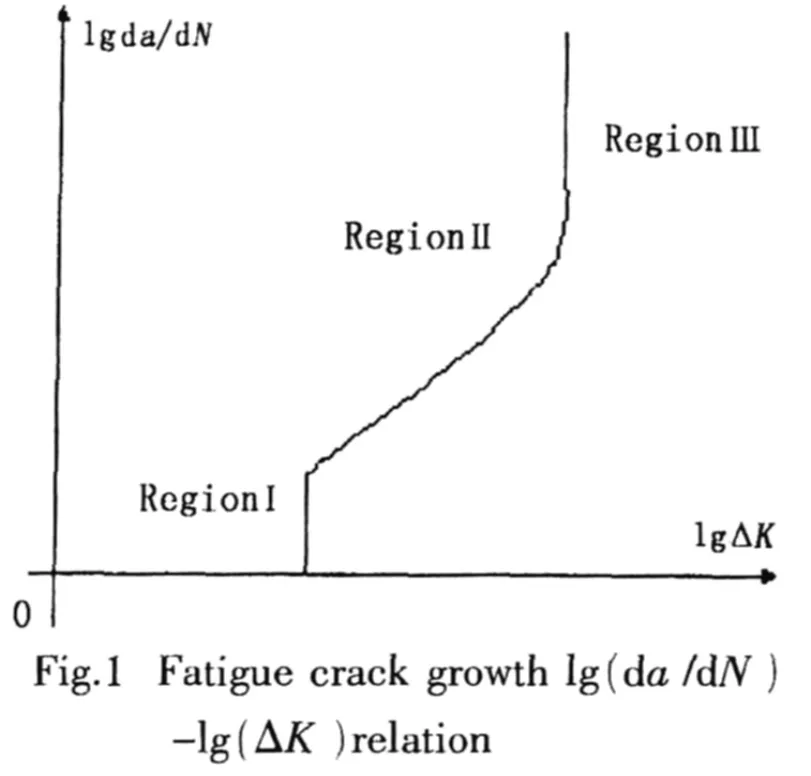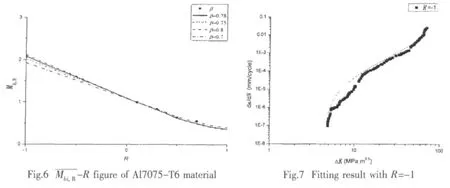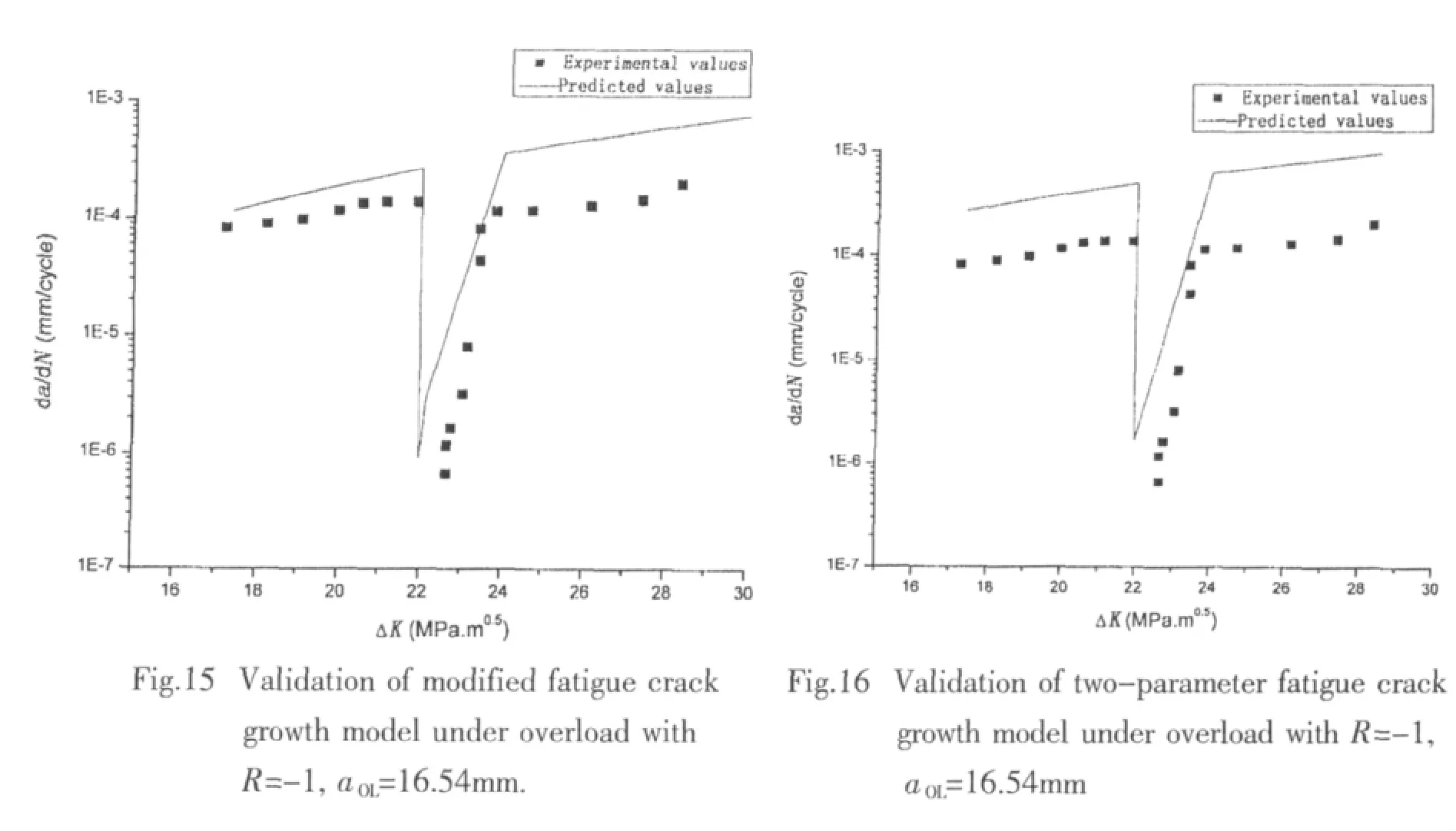A Comparison Between Two Models of Fatigue Crack Growth under Overload
XU Xiao-dong,CUI Wei-cheng,HUANG Xiao-ping
(1 State Key Laboratory of Ocean Engineering,Shanghai Jiao Tong University,Shanghai 200240,China;2 China Ship Scientific Research Center,Wuxi 214082,China)
A Comparison Between Two Models of Fatigue Crack Growth under Overload
XU Xiao-dong1,CUI Wei-cheng2,HUANG Xiao-ping1
(1 State Key Laboratory of Ocean Engineering,Shanghai Jiao Tong University,Shanghai 200240,China;2 China Ship Scientific Research Center,Wuxi 214082,China)
A modified engineering model of fatigue crack growth under overload is introduced to extend the former model to cover Region III.To obtain satisfactory results,a method to determine β value is given.And a comparison analysis between the modified model and another two-parameter model is made.The two models are validated by other Al 7075-T6 material fatigue experimental data under overload.Finally,the differences between the two models are presented and suggestions are given to utilize the two models.
fatigue crack growth;overload;equivalent stress intensity factor range;fracture toughness
Biography:XU Xiao-dong(1984-),male,master of Shanghai Jiao Tong University;
CUI Wei-cheng(1963-),male,Ph.D.,researcher of CSSRC.
Nomenclature
a:half crack length(mm);
ain:initial half crack length(mm);
R:stress ratio;
φp:correction factor for the variable amplitude loading;
Keq0:equivalent stress intensity factor range,corresponding to R=0(MPa);
Kmax,th:maximum stress intensity factor threshold(MPa;
Kmax0:maximum stress intensity factor,corresponding to R=0(MPa);
(da/dN)CA:fatigue crack growth rate under constant amplitude(mm/cycle);
rOL:plastic zone size ahead of the crack tip when the overload occurs(mm);
Pmax:maximum load(MPa);
aOL:half crack length when the overload occurs(mm);
A:constant in present equation;
MR:correction factor for the load ratio;
Kmax:maximum stress intensity factor(MPa);
m,n,r,β,β1:shaping exponents;
ΔKth:stress intensity factor range threshold(MPa);
ΔKth0:stress intensity factor range,corresponding to R=0(MPa);
(da/dN)VA:fatigue crack growth rate under variable amplitude loading(mm/cycle);
ry:plastic zone size ahead of the crack tip(mm);
Kc:fracture toughness of the material(MPa).
1 Introduction
Fatigue is a major cause for the failure of ocean structures[1].People have developed many calculation models to assess the fatigue life of ocean structures.According to the vast amount of experimental data and engineering practice,the calculation models which consider overload effect can give more accurate results.
The fatigue crack propagation is not a linear process,but as a sigmoidal shape shown in Fig.1 which can be divided into three regions.In Region I,the crack growth rate goes asymptotically to zero as ΔK approaches a threshold value ΔKth,there is no crack growth,i.e.,there is a fatigue limit.In Region II,crack growth follows a power law,the socalled Paris-Erdogan crack growth law.In Region III,crack growth is exhibiting a rapidly increasing growth rate towards"infinity",i.e.,ductile tearing and/or brittle fracture.

In order to describe the fatigue crack propagation covering the three regions,Cui and his co-workers have developed several models including the extended McEvily model[2-3],two-parameter model[4]and an engineering model[5].The present paper focuses on the fatigue crack growth model which considers the overload effect and can also describe the three regions of fatigue propagation.Therefore a modified crack growth model is given and Kcis used to extend the model to region III.In this model,an approach according to Wheeler’s[6]is applied to simulate the overload effect.Moreover,the present paper introduces a procedure to obtain the β value in the model from the experimental data by curve-fitting method.The above model is compared to a two-parameter fatigue crack growth model introduced by Cui and Bian[4].Conclusions are given to help utilize the both models.
In the past,the parameters in the fatigue crack growth model are often derived from experimental data by curve-fitting method.Of course,the model can predict such experimental data used for curve-fitting.However,it cannot guarantee that the model can predict the fatigue propagation of the involved material.In the present paper,the experimental data of Al 7075-T6 material under constant amplitude fatigue load from reference[7]are used to derive the parame-ters in the fatigue growth model.The experimental data of Al 7075-T6 material under overload from reference[8]are used to consider the overload effect as well as to validate the fatigue crack growth models.
2 Fatigue crack growth model
In reference[5],the following engineering model for the fatigue crack growth rate has been studied.The fatigue crack growth rate can be calculated by Eq.(1),

This model is extended and re-expressed as Eq.(2)in order to cover the third region,

By comparison,a two-parameter fatigue crack growth model introduced by Cui and Bian[4]is given as Eq.(5)

To consider the overload effect,it is regarded in this paper that the overload can cause plastic area ahead of the crack tip.And the plastic area can cause a retardation of fatigue crack growth rate.The fatigue crack growth rate when overload occurs like Fig.2 can be calculated by Eq.(6)

where φpis the correction factor for the variable amplitude loading.When overload happens,the half crack length is aOLThe overload will cause a plastic zone with the size of rOL,shown in Fig.3.Wheeler[6]figures out that,after a load cycle,as long as the size of the plastic zone rpiis smaller than that caused by overload rpOL,the overload effect will work.When ai+rpiis larger than aOL+rpOL,the overload effect will disappear.In this paper,a modified Wheeler model is used to consider the effect of overload.
φpcan be described as Eq.(7)


where,for Al 7075-T6 material,k=2.6.rpmrcontains both the overload effect and the effective size of plastic zones,which can be described by Eq.(8)

where,aR=aOL+rpOL-rpR,aRcan be calculated by iterative method.
For plane stress conditions,α=1;for plane strain conditions,α=3;for Al 7075-T6 material,p=5.3.
rpiis the size of the plastic zone under the certain load cycle,which can be described by Eq.(9)

where ΔKiis the stress intensity factor range when half crack length equals to a.
rpOLis the size of the plastic zone under overload,which can be described by Eq.(10)

where ΔKOLis the stress intensity factor range when half crack length equals to aOL.
rpRis the size of the plastic zone when the half crack length equals to aR,which can be described by Eq.(11)

where ΔKRis the stress intensity factor range when half crack length equals to aR.
The yield stress of Al 7075-T6 material σy=420.3MPa.
In the experiment,standard specimens of Al 7075-T6 material are used.The stress intensity factor and the half crack length have the relation as Eq.(12)

3 Experimental data and model validation
In the present paper,the fatigue crack growth of Al7075-T6 material under overload is studied.The used experimental data are from references[7-8].
From reference[7],the experimental data of fatigue growth rate of Al 7075-T6 material are shown as Fig.4
Lyster 和Ranta进一步发展了互动假说,并在此基础上提出了互动反馈理论。他们将反馈分为六种类型:重述(用正确的形式复述学习者所用的错误句子),显性修正(直接指出错误并修正),澄清请求(要求学习者复述一遍错误的句子),元语言反馈(通过给予语法规则提示等让学习者自我修正),引导(通过提问等方式引出学生的正确形式),重复(重复错误的地方或整个句子)[17]。近几年,互动反馈对二语习得的促进作用研究成为一个热点,互动反馈与冠词习得的研究也逐渐兴起。

For Al7075-T6 material,the β value in Eq.(4)can be determined by the following steps.
The first step is to obtain different ΔK value(ΔKbi,R)in the experimental data plot where da/dN=bi(bi is an arbitray constant)corresponding to different load ratio R.Let Mbi,R=ΔKbi,R/Kbi,0.1for each bi,where R=-1,0.1,0.3,0.7.Repeat c times,and calculate the average of Mbi,Ras Eq.(14).We also obtain Eq.(13)


Finally,the bi value should be chosen carefully.When it comes to the long life components,the bi value should cover Region I and Region II.For short life components,the bi value should cover Region II and Region III.In the present paper,in order to consider the whole regions of fatigue crack growth,the bi value should cover the above three regions.And β=0.78 is the final curve-fitting result from Fig.6.
After transforming,the parameters in Eq.(2)with R=0 can be determined as given in Tab.1.
The two-parameter fatigue crack growth model introduced by Cui and Bian[4]has 7 parameters to be determined.The curve-fitting results are shown from Fig.7 to Fig.11 and also in Tab.2.


Tab.1 Fitting results of parameters in Eq.(2)when R=0


Tab.2 Fitting results of parameters in Eq.(5)
After curve-fitting,the Kmax,thand ΔKthvalue should be modified according to Fig.12.
The final curve-fitting result after modification is shown in Tab.3.


Tab.3 Fitting results of parameters in Eq.(5)after modification
The experimental data introduced in reference[8]are used to verify the fatigue crack model under overload.The prediction results are shown in Fig.13 to Fig.16.


4 Summary and conclusions
According to the above analysis,it can be concluded that:
(1)Both of the modified fatigue crack growth model introduced in the present paper and the two-parameter fatigue crack growth model can describe the three regions of the fatigue propagation,especially when R>0.When R<0,there are compressive stresses in the load cycle and the compressive stress contributes to the crack growth less.Therefore,the predicted curve is a little higher than the experimental curve.Generally,the predicted results of the two models match the experimental data of Al 7075-T6 well.
(2)The modified Wheeler method is a good way to determine the overload effect.As shown in this paper,the overload effect on Al7075-T6 material is successfully predicted.
(3)By comparison,the modified fatigue crack growth model has fewer parameters to be determined.Most of the parameters can be determined by curve-fitting method using the experimental plot regarding to R=0.However,the two-parameter fatigue crack growth model has many parameters to be determined regarding to each load ratio.The characteristics of the material which is studied should be known well.
Suggestions are given to utilize the two models.
(1)To have more accurate results,a β value should be well determined by curve-fitting method regarding to different materials.A procedure has been given in this paper.
(2)Load sequence effect other than overload,such as underload and block loading on fatigue crack growth of Al7075-T6 material,should be studied in the following research work.
(3)Other materials and loading conditions should be validated using the present fatigue crack growth model in the following research work.
[1]Cui W C.A state-of-the-art review on fatigue life prediction methods for metal structures[J].Journal of Marine Science and Technology,2002,7(1):43-56.
[2]Cui W C,Huang X P.A general constitutive relation for fatigue crack growth analysis of metal structures[J].Acta Metall Sinica,2003,16:342.
[3]Wang Y F,Cui W C,Wu X Y,Wang F,Huang X P.The extended McEvily model for fatigue crack growth analysis of metal structures[J].Int J Fatigue,2008,30:1851-1860.
[4]Cui W C,Bian R G,Liu X C.Application of the two-parameter unified approach for fatigue life prediction of marine structures[C]//PRADS 2007.Shanghai,China,2007:392.
[5]Huang X P,Moan T,Cui W C.An engineering model of fatigue crack growth under variable amplitude loading[J].Int J Fatigue,2008,30:2-10.
[6]Wheeler O E.Spectrum loading and crack growth[J].J Basic Engng,Transactions of ASME,Series D 1972,94:181-186.
[7]Newman,Jr,J C,Phillips E P,Everett R A.Fatigue analyses under constant and variable amplitude loading using smallcrack theory[R].NASA/TM-1999-209329,ARL-TR-2001.
[8]Zhao T W,Zhang J X,Jiang Y Y.A study of fatigue crack growth of 7075-T651 aluminum alloy[J].Int J Fatigue,2008,30:1169-1180.
过载作用下两种疲劳裂纹扩展模型的比较
徐晓冬1,崔维成2,黄小平1
(1上海交通大学 海洋工程国家重点实验室,上海 200030;
2中国船舶科学研究中心,江苏 无锡 214082)
文章改进了一种疲劳裂纹扩展模型,将原来的模型描述范围扩展到疲劳裂纹扩展的第三个阶段,并给出了一种确定模型中β值的方法。文中还将该模型与另外一种双参数疲劳裂纹扩展模型进行了比较,两种模型都通过7075-T6铝在过载作用下的疲劳试验数据进行了验证。最后,给出了比较结果,以及对两种模型应用的建议。
疲劳裂纹扩展;过载;等效应力强度因子范围;疲劳韧性
U661.4
A
徐晓冬(1984-),男,上海交通大学硕士研究生;
黄小平(1964-),男,上海交通大学副教授,硕士生导师。
TG113.25+5 U661.4
A
1007-7294(2010)03-0263-09
date:2009-11-09
This study was supported by Natural Science Fund of Shanghai,Project No.08ZR1410000 and the Innovative Scholars Support Program of Jiangsu Province,2008-2010.The first author has also benefited from Dr Bian,R.G.(China Ship Scientific Research Center,China)for helpful discussion and Dr Wang,L.P.(Shanghai Jiao Tong University,China)for writing skills.
崔维成(1963-),男,博士,中国船舶科学研究中心研究员,博士生导师;

